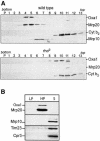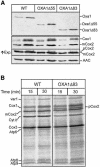Yeast Oxa1 interacts with mitochondrial ribosomes: the importance of the C-terminal region of Oxa1
- PMID: 14657017
- PMCID: PMC291819
- DOI: 10.1093/emboj/cdg624
Yeast Oxa1 interacts with mitochondrial ribosomes: the importance of the C-terminal region of Oxa1
Abstract
The yeast mitochondrial Oxa1 protein is a member of the conserved Oxa1/YidC/Alb3 protein family involved in the membrane insertion of proteins. Oxa1 mediates the insertion of proteins (nuclearly and mitochondrially encoded) into the inner membrane. The mitochondrially encoded substrates interact directly with Oxa1 during their synthesis as nascent chains and in a manner that is supported by the associated ribosome. We have investigated if the Oxa1 complex interacts with the mitochondrial ribosome. Evidence to support a physical association between Oxa1 and the large ribosomal subunit is presented. Our data indicate that the matrix-exposed C-terminal region of Oxa1 plays an important role supporting the ribosomal-Oxa1 interaction. Truncation of this C-terminal segment compromises the ability of Oxa1 to support insertion of substrate proteins into the inner membrane. Oxa1 can be cross-linked to Mrp20, a component of the large ribosomal subunit. Mrp20 is homologous to L23, a subunit located next to the peptide exit tunnel of the ribosome. We propose that the interaction of Oxa1 with the ribosome serves to enhance a coupling of translation and membrane insertion events.
Figures






References
-
- Ban N., Nissen,P., Hansen,J., Moore,P.B. and Steitz,T.A. (2000) The complete atomic structure of the large ribosomal subunit at 2.4 Å resolution. Science, 289, 905–920. - PubMed
-
- Bauer M., Behrens,M., Esser,K., Michaelis,G. and Pratje,E. (1994) PET1402, a nuclear gene required for proteolytic processing of cytochrome oxidase subunit 2 in yeast. Mol. Gen. Genet., 245, 272–278. - PubMed
-
- Bonnefoy N., Chalvet,F., Hamel,P., Slonimski,P.P. and Dujardin,G. (1994) OXA1, a Saccharomyces cerevisiae nuclear gene whose sequence is conserved from prokaryotes to eukaryotes controls cytochrome oxidase biogenesis. J. Mol. Biol., 239, 201–212. - PubMed
-
- Borst P. and Grivell,L.A. (1978) The mitochondrial genome of yeast. Cell, 15, 705–723. - PubMed
-
- Eichacker L.A. and Henry,R. (2001) Function of a chloroplast SRP in thylakoid protein export. Biochim. Biophys Acta, 1541, 120–134. - PubMed
Publication types
MeSH terms
Substances
LinkOut - more resources
Full Text Sources
Other Literature Sources
Molecular Biology Databases

